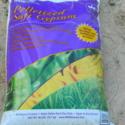One "trick" to digging clay is to adjust its moisture carefully.
Too dry = too hard = you need a pick.
Too wet = sticky and it compacts permanently
Just the right amount of water makes it less hard and somewhat less sticky, but still a pain to work with.
My preference is to swing a heavy pick, and dig it in chunks a little on the dry side. That way it won't compact into permanent bricks.
I BELIEVE, but can't prove, that organic matter leaching down into a layer of hard clay does soften it gradually, as years of accumulating soluble organics attract soil microbes, insects and worms. I think this because I carve my raised beds out of hard clay, building the root zone down as well as up. After a year or two, the "floor" of these raised beds becomes softer as water drains (very slowly) from the raised bed soil into the clay layer under it.
(I do dig drainage trenches to lower points in the yard so that the bed, the "floor" and the clay layer under it have somewhere to drain TO without relying on the very slow "perk" rate through dense clay.)
Pedogenesis (making soil from dead minerals):
When I'm screening out rocks and roots, the clay has to be a little on the dry side or it will stick together and coat the screen. Not bone dry, or I can't crush it enough to fit through 1/4" hardware cloth.
Then I mix it with some amendments including compost (and fine bark or coarse sand if I have enough). That way, whatever is broken up mixes with the amendments instead of reverting to pudding. NOW, when moistened slightly and crushed and screened again , it might mix in finer clumps with the amendments. If I have enough new soil "in process", I also age it this way and hope that roots and soil life will do a little micro-mixing.
(At this stage, I'm fighting to break up small "clay balls". Sometimes I just set the clay balls aside for later processing, on the theory that they are the purest and meanest clay in my soil.)
I also bought a bag of gypsum (CaSO4), but used it sparingly and saw no difference over a few years. Maybe the improvement was there but I didn't realize it, or I should have used more.
Edited to add:
Since then I have read, from people I trust, that the benefit of gypsum is only seen in SODIC soils (soils with a lot of sodium salts). No wonder I see no benefit from gypsum: I have low-salt soil!
